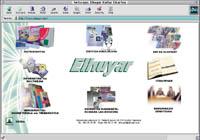Internet: XXI. Main means of communication of the century

As is already known, the Internet is a network of computer networks with many possibilities: it can be a powerful media, a great virtual shop, a market, a game and a game, a tool of work, a space to do business, a tool to offer “garbage”…. The origin of the network of computer networks, in short of the web, can be placed at the end of the 60s. In early September 1969, according to all the chronicles, the United States Department of Defense created the ARPANET (Advanced Research Projects Agency Net) network to communicate its sub-departments. The start, however, was not successful, as the attempt to connect the first two computers failed.
Despite the difficulties, due to the rapid growth of the network, those responsible for the United States Department of Defense divided the network into two parts, each with its functions. One continued to be the name ARPANET and the other named MILNET. The sum of both, maintaining the founding spirit, was called DARPANET (Defense Advanced Research Projects Agency Net). To ensure communication between both networks, that is, to ensure that they could exchange information between them, they had to develop a communication protocol known as IP (Internet Protocol). This IP is the basic origin of the current TCP/IP protocol (Terminal Control Protocol).
At that time, however, the protocol only allowed communication between both networks. It was a political decision, since the IP protocol was designed and able to ensure communication between thousands of networks.
In the late 1980s, the American Science Foundation (NSF) created its own network. The aim of the network was to achieve communication between the five supercomputing centers of the aforementioned Foundation, the exchange of information. The Foundation obtained the permission to access the DARPANET network so it could take advantage of the IP protocol for its communication. Then other networks emerged, some making their own way, others entering the network realized, others creating many others and disappearing in very little time… It was the beginning of the creation of the Internet.
However, the Internet was about to create. Once the network was created, why say that it was between the Internet? Because the integration of all networks in a single environment was lacking. Although the origin of the network of networks is military, the network of webs is based on scientific needs. The gigantic Amaraun, the World Wide Web (www), a network of services that are grouped and unified in the same environment, of scientific origin, was created in Geneva, in the European Laboratory of Particle Physics (CERN) of this city. Although the design of the WWW was carried out in 1991, the Internet would not enter the world until 1994. The new network intended to respond to the needs of the scientists working in the Geneva laboratory, with the aim of exchanging quickly, flexibly and comfortably the results of all the trials that were carried out there. It was a simple system, with conventional navigation software, which demands content from www to the hired server.
Therefore, the huge web that has made the small world was born in Europe. However, despite the European creation of the web, development has occurred in the United States, where most of the tools that make servers are found.
To convert mass media?
With the tool of leaving the small world, will the Internet become a mass media like television? At first glance you can see four basic features that distinguish the Internet from traditional mass media: written press, radio and television:
- In a few years Internet has achieved a large number of users.
- On the Internet, for the moment, there is no censorship, that is to say, to put something on the net it is not necessary to pass previously the control sieves. Users themselves can be informers.
- On the Internet you can get a direct relationship between the donor and the recipient.
- Internet contains text, image, fixed and with movement, and sound.
However, experts on ethical issues consider that the Internet is not yet a mass media outlet. According to them, in the contents of the Internet, quantity is more important than quality, and that being a means of communication must require or not comply with a minimum. When it reaches television, the Internet mass media will become the XXI. the main means of communication of the twentieth century.
Published in 7K
Buletina
Bidali zure helbide elektronikoa eta jaso asteroko buletina zure sarrera-ontzian











